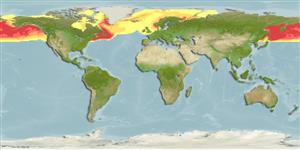Classification / Names
Common names from other countries
Main reference
Size / Weight / Age
Max length : 20.0 cm TL male/unsexed; (Ref. 11626); 25.2 cm TL (female); common length : 15.0 cm TL male/unsexed; (Ref. 4645); max. published weight: 52.00 g (Ref. 56475); max. reported age: 10 years (Ref. 72498)
Length at first maturity
Lm 13.5, range 15 - 19 cm
Environment
Marine; freshwater; brackish; pelagic-oceanic; anadromous (Ref. 46888); depth range 0 - 725 m (Ref. 58426), usually ? - 200 m (Ref. 96339)
Climate / Range
Polar, preferred 3°C (Ref. 107945); 79°N - 40°N, 180°W - 180°E (Ref. 54574)
Distribution
Circumpolar in the Arctic. North Atlantic: Barents Sea up to Bear Island, in the White and Norwegian seas, off the coast of Greenland up to 74°N and from Hudson Bay in Canada to Gulf of Maine, USA. North Pacific: south to Korea and Juan de Fuca Strait, Canada.
Countries | FAO areas | Ecosystems | Occurrences | Introductions
Short description
IUCN Red List Status (Ref. 115185)
Threat to humans
Harmless
Human uses
Fisheries: highly commercial
Tools
Special reports
Download XML
Internet sources
Estimates of some properties based on models
Phylogenetic diversity index
PD50 = 1.0000 many relatives (e.g. carps) 0.5 - 2.0 few relatives (e.g. lungfishes)
Trophic Level
3.2 ±0.1 se; Based on diet studies.
Resilience
Medium, minimum population doubling time 1.4 - 4.4 years (K=0.3-0.5; tm=3; tmax=10; Fec=6,000)
Vulnerability
Low to moderate vulnerability (27 of 100)
Price category
